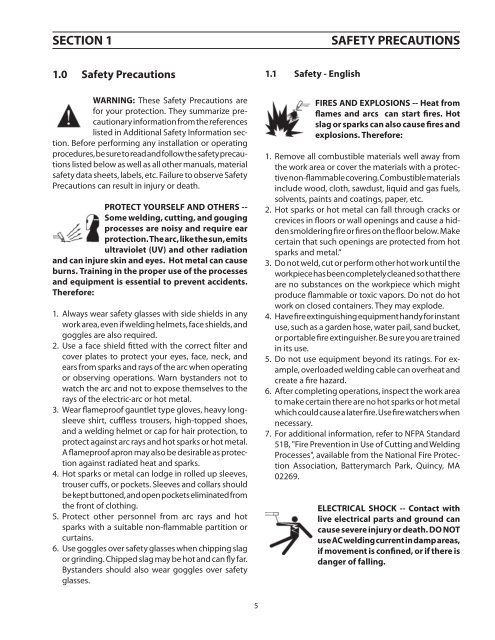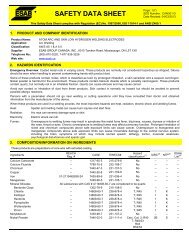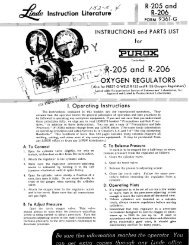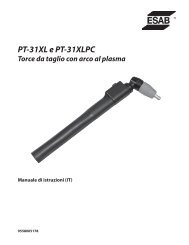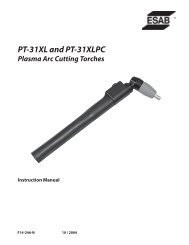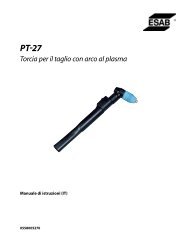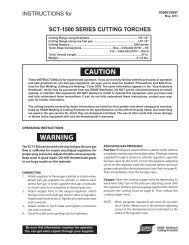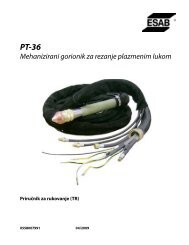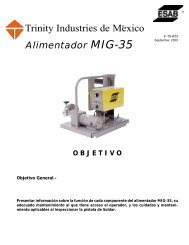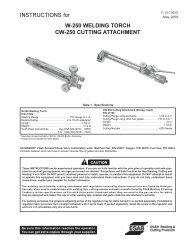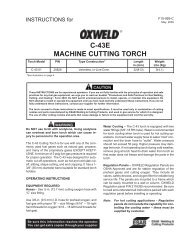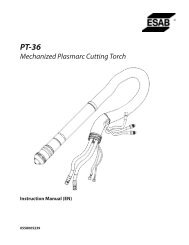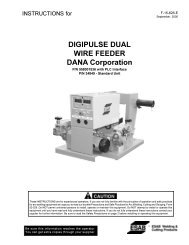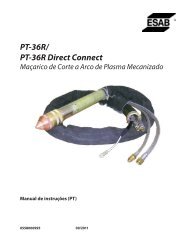Mechanized Plasmarc Cutting Torch - ESAB Welding & Cutting ...
Mechanized Plasmarc Cutting Torch - ESAB Welding & Cutting ...
Mechanized Plasmarc Cutting Torch - ESAB Welding & Cutting ...
Create successful ePaper yourself
Turn your PDF publications into a flip-book with our unique Google optimized e-Paper software.
section 1<br />
safety precautions<br />
1.0 Safety Precautions 1.1 Safety - English<br />
WARNING: These Safety Precautions are<br />
for your protection. They summarize precautionary<br />
information from the references<br />
listed in Additional Safety Information section.<br />
Before performing any installation or operating<br />
procedures, be sure to read and follow the safety precautions<br />
listed below as well as all other manuals, material<br />
safety data sheets, labels, etc. Failure to observe Safety<br />
Precautions can result in injury or death.<br />
PROTECT YOURSELF AND OTHERS --<br />
Some welding, cutting, and gouging<br />
processes are noisy and require ear<br />
protection. The arc, like the sun, emits<br />
ultraviolet (UV) and other radiation<br />
and can injure skin and eyes. Hot metal can cause<br />
burns. Training in the proper use of the processes<br />
and equipment is essential to prevent accidents.<br />
Therefore:<br />
1. Always wear safety glasses with side shields in any<br />
work area, even if welding helmets, face shields, and<br />
goggles are also required.<br />
2. Use a face shield fitted with the correct filter and<br />
cover plates to protect your eyes, face, neck, and<br />
ears from sparks and rays of the arc when operating<br />
or observing operations. Warn bystanders not to<br />
watch the arc and not to expose themselves to the<br />
rays of the electric-arc or hot metal.<br />
3. Wear flameproof gauntlet type gloves, heavy longsleeve<br />
shirt, cuffless trousers, high-topped shoes,<br />
and a welding helmet or cap for hair protection, to<br />
protect against arc rays and hot sparks or hot metal.<br />
A flameproof apron may also be desirable as protection<br />
against radiated heat and sparks.<br />
4. Hot sparks or metal can lodge in rolled up sleeves,<br />
trouser cuffs, or pockets. Sleeves and collars should<br />
be kept buttoned, and open pockets eliminated from<br />
the front of clothing.<br />
5. Protect other personnel from arc rays and hot<br />
sparks with a suitable non-flammable partition or<br />
curtains.<br />
6. Use goggles over safety glasses when chipping slag<br />
or grinding. Chipped slag may be hot and can fly far.<br />
Bystanders should also wear goggles over safety<br />
glasses.<br />
FIRES AND EXPLOSIONS -- Heat from<br />
flames and arcs can start fires. Hot<br />
slag or sparks can also cause fires and<br />
explosions. Therefore:<br />
1. Remove all combustible materials well away from<br />
the work area or cover the materials with a protective<br />
non-flammable covering. Combustible materials<br />
include wood, cloth, sawdust, liquid and gas fuels,<br />
solvents, paints and coatings, paper, etc.<br />
2. Hot sparks or hot metal can fall through cracks or<br />
crevices in floors or wall openings and cause a hidden<br />
smoldering fire or fires on the floor below. Make<br />
certain that such openings are protected from hot<br />
sparks and metal.“<br />
3. Do not weld, cut or perform other hot work until the<br />
workpiece has been completely cleaned so that there<br />
are no substances on the workpiece which might<br />
produce flammable or toxic vapors. Do not do hot<br />
work on closed containers. They may explode.<br />
4. Have fire extinguishing equipment handy for instant<br />
use, such as a garden hose, water pail, sand bucket,<br />
or portable fire extinguisher. Be sure you are trained<br />
in its use.<br />
5. Do not use equipment beyond its ratings. For example,<br />
overloaded welding cable can overheat and<br />
create a fire hazard.<br />
6. After completing operations, inspect the work area<br />
to make certain there are no hot sparks or hot metal<br />
which could cause a later fire. Use fire watchers when<br />
necessary.<br />
7. For additional information, refer to NFPA Standard<br />
51B, "Fire Prevention in Use of <strong>Cutting</strong> and <strong>Welding</strong><br />
Processes", available from the National Fire Protection<br />
Association, Batterymarch Park, Quincy, MA<br />
02269.<br />
ELECTRICAL SHOCK -- Contact with<br />
live electrical parts and ground can<br />
cause severe injury or death. DO NOT<br />
use AC welding current in damp areas,<br />
if movement is confined, or if there is<br />
danger of falling.<br />
5


